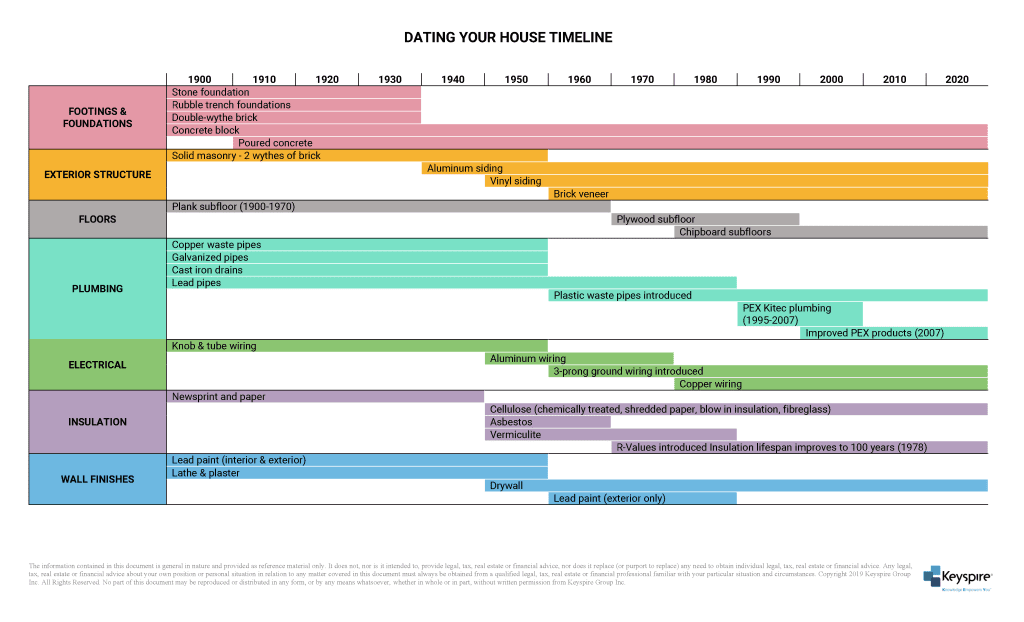What You Should Look For in an Older Property

The ability to date a property based on the materials it was built with could impact your renovation plans, long-term budgeting, and even your insurance policy.
- Footings & Foundations: Earth stone or post in ground construction, padstones, stone foundations, rubble trench foundations, brick, poured concrete, concrete block
- Exterior Structure: Framing, roof, windows
- Floor Joists & Sub Floors: wood plans, plywood, chipboard, steel beams, I-joist
- Plumbing: Copper waste, galvanizes, cast iron, lead, plastic waste, Kitec
- Electrical: Knob & tube wiring, aluminum wiring, 3-pring ground wiring, copper wiring
- Insulation: Newsprint & paper, cellulose insulation, asbestos, vermiculite, R-values
- Interior Finishes: Lathe & plaster, drywall, paint
- Mechanical Systems: HVAC system
Refer to the “Dating Your House Timeline” for a snapshot look that will help you determine the age of your house:

Check out the transcript of the video below:
Dating a home can really help you determine a lot of things that may be required about upgrades. If you’re looking at, and you can see some upgrades have been done well, then it might give you an idea to what extent if you still see some old things that weren’t upgraded in there it can help identify hazardous materials in a property which will cover a lot of during this as well.
And then what type of replacements will have to be done to your aging home systems, if it’s HVAC, roofing, electrical, plumbing. So we’re going to cover a lot of stuff there. A lot of homes built before the eighties, they may have been built with materials that we deem hazardous now: PCBs is one of them. Lead asbestos, a different variety of stuff was used to the different types of manufacturing back in those days. And some of them are still used today elsewhere in the world, but we try to, stay away from those things in North America.
For sure.
At a glance we’ve got this really awesome chart. We’re gonna send this out to you guys. It’s a chart. We’re gonna, make sure that it’s all up to date and whatnot. But in here you can see, we talked a little bit about what if there’s solid masonry, two widths of brick? That’s the exterior structure. It’s part, maybe part of the foundation… if it’s all part of the foundation as well, I know this house is older than 1930.
Yeah.
And if it’s older than 1930, I can expect that I might find some copper waste lines. I might find some galvanized pipes.
That’s a great tool.
Cast iron drains or whatnot, right? Like I may find different things. If I find one, there’s probably an indicator that there may be other parts, right?
Look it if you know the house is built in 1950, then there’s lots of things here. There, there could be different types of plumbing in that, even newer stuff. There could be the aluminum wiring, there could be no grounds in there. The insulation could be a variety of things.
So again, these are ways to look for other building materials and systems in the homes that you wouldn’t normally think of.
Yeah.
Like without that chart. And if I didn’t know any better, I may find something in plumbing, but I wouldn’t know to look for something in electrical or insulation.
Because I don’t know what I don’t know. And this helps you.
Yeah. This will help you for sure.
Recent Blogs
The Best Time To “Cash Out” Is…
“When should I ‘cash out’ and sell my properties?” I hear this question a lot and it blows my…
Attract Higher Paying Tenants by Being Pet Friendly!
Optimizing an investment property is all about maximizing your income and minimizing your workload and expenses, such as tenant turnover.…
The 7-Step JV Process
“It’s better to own 10% of 100 properties than 100% of 1 property.” No matter how wealthy and successful…
Income Vs Net Worth
In today’s world, two of the most important financial metrics are income and net worth. Understanding the distinction between the…




